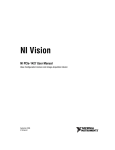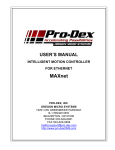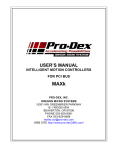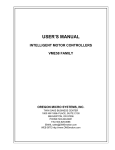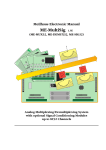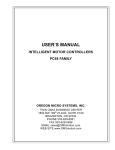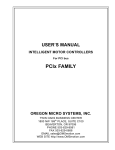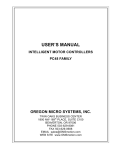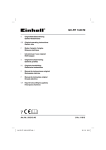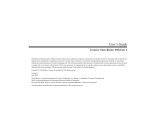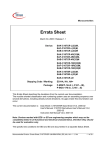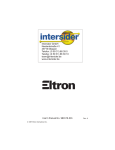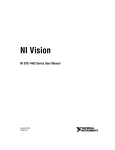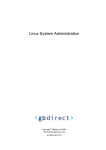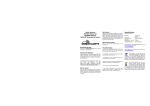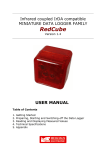Download PDF datasheet, specs - Meilhaus Electronic
Transcript
Produkt-Datenblatt, tech. Daten Pro-Dex OMS Motion-Control Kontakt Technischer und kaufmännischer Vertrieb, Preisauskünfte, Angebote, Test-Geräte, Beratung vor Ort: Tel: (0 89) 89 01 66-0 FAX: (0 89) 89 01 66-77 Aus dem Ausland: Tel: ++49 - 89 - 89 01 66-0 FAX: ++49 - 89 - 89 01 66-77 E-Mail: [email protected] Internet: www.meilhaus.com/pro-dex Web Kontakt-Formular: www.meilhaus.com/kontakt Per Post: Meilhaus Electronic GmbH Fischerstraße 2 D-82178 Puchheim MEsstechnik fängt mit ME an. www.meilhaus.com Erwähnte Firmen- und Produktnamen sind zum Teil eingetragene Warenzeichen der jeweiligen Hersteller. Preise in Euro zzgl. gesetzl. MwSt. Irrtum und Änderung vorbehalten. © 2010 Meilhaus Electronic bzw. Icron. ME-Cover_fuer_ProDex 1 16.11.2010, 9:08:41 Uhr MAXnet Pg. 1 MAXnet Ethernet 5-Axis Motion Controller FEATURES Ethernet or RS232 Communications • • Ethernet utilizes standard TCP/IP protocol. RS232 Baud rate = 9600 to 115.2K • Delivers exceptional servo control on multiaxis applications. Identical outcomes when utilizing one or all axes of motion. Configurable PID filter with feed forward coefficients. Control signals • PID update rate of 122 μs on all 5 axes • • 266 MHz, 32-bit RISC processor • Updates all signals and data points providing superior application control. Controller I/O Capabilities • • • • Each axis has +Limit, -Limit, Home, Auxiliary out, and axis control out. 8 General purpose bi-directional TTL I/O 1 General purpose analog output with 16 bit, +/-10 VDC input (in addition to axes output). 2 Channels of general purpose analog input with 16-bit (+/-10 VDC) Motion Feedback • • Each axis has an incremental encoder input Quadrature Encoder Feed back up to 16 MHz on all encoder inputs. Sophisticated Control Functionality • • • • • • 16 bit DAC analog resolution. Step pulses from 0 to 4,194,303 steps per second (+/- 0 steps). Backlash compensation. Custom, parabolic, “S”-Curve & linear trajectory profiles. Real time encoder position capture. S-Curve with 4-quadrant jerk parameters. Pro-Dex, Inc. • • Single 100-pin SCSI type connector for high density signal connection. 8 “user definable” digital I/O. Analog out per each axis can be used as general purpose when axis is configured for Step control. ADDITIONAL FEATURES - Small form-factor, 4in. x 6.5in. Stand-alone capability Custom Power-up Defaults Non-Volatile Macro Storage Patented technology to minimize torque ripple and velocity modulation Internal Watchdog timer for safety Slip & Stall detection with encoder feedback Linear/Circular interpolation Constant and variable velocity contouring (all axes) Single-axis, multi-axis and multi-tasking modes Output is +/-10V, or Step & Direction per Axis Independent home and plus / minus over-travel inputs for each axis Auxiliary output per axis for Amp/Drive enable Commands are intuitive for programming ease. Over 250 ASCII character commands, “universal” to current and previous OMS controllers Capable of conversion to “user” defined units i.e. inches/ revolutions if desired. Designed for expandability (custom solutions) Person to person toll-free tech support: 800-707-8111 OMS has more than 28 years proven success Beaverton, Oregon MAXnet Pg. 2 DESCRIPTION The MAXnet family of Motion Controllers brings the Oregon Micro Systems, Inc. (OMS) intelligent motion control technology to a new level of servo applications as well as stepping motors. A much more powerful 266 MHz 32 Bit RISC processor (PowerPC) provides the capability and power for better and more sophisticated application control. This newest generation of motion control products provides up to 5 axes of motion control on a single 4 x 6.5 inch card. Each axis can be selected by the user to be an open or closed stepper or a high capability servo axis. In addition, independent analog inputs are provided to enable integration of analog parameters such as velocity override, temperature, pressure, etc., under the control of the running application. An additional general purpose analog output is also available. Outputs are provided for 16 bit analog servo output as well as step and direction for stepper system applications. The servo loop is a PID filter with feedforward coefficients and an update rate of 122 μs on all 5 axes. Independent plus and minus limits, a home switch input, and an auxiliary output provided for each of the 5 axes so that the state of any of them can be monitored by the system at any time. An additional 8 User Definable I/O is available for synchronization and control of other events. Incremental encoder feedback, differential or single ended, is used for all servo axes and is available for position feedback and may also be used for slip or stall detection. PROGRAMMING The MAXnet motion controllers are easily programmed with character ASCII commands through an extensive command structure. The commands are combined into character strings to create sophisticated motion profiles, with features such as IO and other functionality. A separate FIFO command queue for each axis is used to store the commands once they are parsed in the MAXnet. These commands are then executed sequentially, allowing the host to send a complex command sequence and attend to other tasks, while the MAXnet manages the motion process. These command queues can store 2559 command values and can include a loop counter that allows multiple execution of any command string. There are approximately 200 commands available. All commands are sent to the controller as two or three character strings. Some of these commands expect one or more numerical operands to follow. These commands are identified with“#” after the command in the description. The “#” indicates a signed integer input parameter, or a signed fixed point number of the format ##.# when User Units are enabled. User Units define distances, Velocity and acceleration parameters, and represent the input in Inches, millimeters, revolution, etc. Pro-Dex, Inc. Synchronized moves may be made by entering the AA or AM command mode. This form of the command performs a context switch that allows entering commands in the format MRx#,y#,z#,t#,u#; Numbers are entered for each axis commanded to move. An axis may be skipped by entering a comma {,} at the appropriate axis position with no value parameter. The command may be prematurely terminated with a semicolon (;) i.e. a move requiring only the X and Y axes to move would use the command MRx#,y#; followed by the GO command. Each axis programmed to move will start together upon execution of the GO command. The MAXnet can be switched back to independent-axis mode by entering the desire single axis command, such as AX. PROGRAMMING EXAMPLES In a typical move requirement where it is desired to home the stage and then move to a specified position, the following will demonstrate the programming for a single axis: Initialize the velocity and acceleration parameters to a suitable value. Set the PID filter gain values. Perform the homing operation initializing the position counter to zero. Perform a motion to the absolute position of 10,000 and set the done flag for that axis when the move is finished. AX; VL5000; AC50000; KP20; KI1; KD45; HN; HM0; MA10000; GO; ID; In a move requiring a three axis coordinated move to a position, the following could be used: AX; KP2; KD6; HN; AY; KP2; KD6; HN; AZ; KP2; KD6; HN; AM; VL5000,5000,5000; AC50000,50000,50000; MA1000,2000,3000; GO; ID; The controller would calculate the relative velocities required to perform a straight line move from the current position to the desired position. Beaverton, Oregon MAXnet Pg. 3 SPECIFICATIONS Velocity Analog outputs (servo) 0 to 4,194,303 pulses per second simultaneous on each axis Acceleration +/-10V and 0 to +10V, max. One per axis plus one general purposes, 16 Bit resolution Step pulse output 0 to 8,000,000 pulses per second per second Position range Pulse width 50% duty cycle. Open collector level signal (TTL). ± 2,147,487,647 Accuracy Position accuracy and repeatability ±0 counts for point to point moves Velocity accuracy ±0.01% of peak velocity in jog mode. Environmental Operating temperature range: 0 to 50 degrees centigrade Storage temperature range: -20 to 85 degrees centigrade Direction output Open collector level signal (TTL). Encoder feedback Maximum 16 MHz after 4x quadrature detection. Differential signal. Reference IEEE 802 Software Humidity: 0 to 90% non-condensing Power Software interface utilities provided. High level expertise not required. Over 250 ASCII character commands, expanded from current OMS command set while backwards compatible. +5VDC +/-5% at 1 amp typical +12VDC at 0.1 amp typical = +/-5% -12VDC at 0.1 amp typical = +/-10% Dimensions 4” x 6.5” x 0.7” Limit switch inputs TTL input signals Active low or high, selectable by command input for each axis (active low is default) Connector One shielded 100-Pin SCSI type connector for all signals (motor control, I/O, Limits, etc). Breakout board available for ease of cabling. Home switch inputs TTL input signals Active low or high, selectable by command input for each axis (active low is default) User definable I/O Up to 8 bits of user definable digital I/O. The 8 bits are user configurable and are configured as 4 inputs and 4 outputs as defaults from the factory. “The Company in Motion” Analog inputs Two independent resolution, +/- 10V. Pro-Dex, Inc. analog inputs, 16 Bit Beaverton, Oregon MAXnet Pg. 4 Control Signals 100-Pin SCSI Type 4” Power 6-Pin RS232 9-Pin Ethernet RJ45 6.5” Ordering Information Model No. of Axes MAXnet-1000 1 MAXnet-2000 2 MAXnet-3000 3 MAXnet-4000 4 MAXnet-5000 5 IOMAXnet CBL58-3M ACCESSORIES I/O Breakout Board for MAXnet I/O cable for MAXnet to IOvMAX, 3 meters 3701-1800000 Revision B Pro-Dex, Oregon Micro Systems Beaverton, Oregon MAXnet w/DBnet Pg. 1 MAXnet w/DBnet Ethernet 10-Axis Motion Controller FEATURES Ethernet or RS232 Communications • • Control signals • Ethernet utilizes standard TCP/IP protocol. RS232 Baud rate = 9600 to 115.2K PID update rate of 122 μs on all 10 axes • • • Delivers exceptional servo control on multiaxis applications. Identical outcomes when utilizing one or all axes of motion. Configurable PID filter with feed forward coefficients. 266 MHz, 32-bit RISC processor • Updates all signals and data points providing superior application control. Controller I/O Capabilities • • • • Each axis has +Limit, -Limit, Home, Auxiliary out, and axis control out. 16 General purpose bi-directional TTL I/O 2 General purpose analog output with 16 bit, +/-10 VDC input (in addition to axes output). 4 Channels of general purpose analog input with 16-bit (+/-10 VDC) Motion Feedback • • • Each axis has an incremental encoder input Quadrature Encoder Feed back up to 16 MHz on all encoder inputs. Absolute encoder feedback (options for all axes up to 32-bit resolution) Sophisticated Control Functionality • • • • • • 16 bit DAC analog resolution. Step pulses from 0 to 4,194,176 steps per second (+/- 0 steps). Backlash compensation. Custom, parabolic, “S”-Curve & linear trajectory profiles. Real time encoder position capture. S-Curve with 4-quadrant jerk parameters. • • Two 100-pin SCSI type connectors for high density signal connection. 16 “user definable” digital I/O. Analog out per each axis can be used as general purpose when axis is configured for Step control. ADDITIONAL FEATURES - Small form-factor, 4” x 6.5” x 1.64” Stand-alone capability Custom Power-up Defaults Non-Volatile Macro Storage Patented technology to minimize torque ripple and velocity modulation Internal Watchdog timer for safety Slip & Stall detection with encoder feedback Linear/Circular interpolation Constant and variable velocity contouring (all axes) Single-axis, multi-axis and multi-tasking modes Output is +/-10V, or Step & Direction per Axis Independent home and plus / minus over-travel inputs for each axis Auxiliary output per axis for Amp/Drive enable Commands are intuitive for programming ease. Over 250 ASCII character commands, “universal” to current and previous OMS controllers Capable of conversion to “user” defined units i.e. inches/ revolutions if desired. Designed for expandability (custom solutions) Person to person toll-free tech support: 800-707-8111 OMS has more than 28 years proven success Pro-Dex, Inc./OMS Beaverton, Oregon MAXnet w/DBnet DESCRIPTION The MAXnet family of Motion Controllers has been expanded to provide up to 10 axis of intelligent motion control. A powerful 266 MHz 32 Bit RISC processor (PowerPC) provides the capability and power for better and more sophisticated application control. This newest generation of motion control products provides up to 10 axes of motion control on a two board stack of 4 x 6.5 x 1.64 inches. Each axis can be selected by the user to be an open or closed stepper or a high capability servo axis. In addition, independent analog inputs are provided to enable integration of analog parameters such as velocity override, temperature, pressure, etc., under the control of the running application. Two additional general purpose analog outputs are also provided. Outputs are provided for 16 bit analog servo output as well as step and direction for stepper system applications. The servo loop is a PID filter with several coefficients and an update rate of 122 μs on all 10 axes. Independent plus and minus limits, a home switch input, and an auxiliary output provided for each of the 10 axes so that the state of any of them can be monitored by the system at any time. An additional 16 User Definable I/O is available for synchronization and control of other events. Incremental encoder feedback, differential or single ended, is used for all servo axes and is available for position feedback and may also be used for slip or stall detection. PROGRAMMING The MAXnet motion controllers are easily programmed with character ASCII commands through an extensive command structure. The commands are combined into character strings to create sophisticated motion profiles, with features such as IO and other functionality. A separate FIFO command queue for each axis is used to store the commands once they are parsed in the MAXnet. These commands are then executed sequentially, allowing the host to send a complex command sequence and attend to other tasks, while the MAXnet manages the motion process. These command queues can store 2559 command values and can include a loop counter that allows multiple execution of any command string. There are approximately 250 commands available. All commands are sent to the controller as two or three character strings. Some of these commands expect one or more numerical operands to follow. These commands are identified with“#” after the command in the description. The “#” indicates a signed integer input parameter, or a signed fixed point number of the format ##.# when User Units are enabled. User Units define distances, Velocity and Acceleration parameters, and represent the input in Inches, millimeters, revolution, etc. Pro-Dex, Inc./OMS Pg. 2 Synchronized moves may be made by entering the AA or AM command mode. This form of the command performs a context switch that allows entering commands in the format MRx#,y#,z#,t#,u#,v#,r#,s#,w#,k#; Numbers are entered for each axis commanded to move. An axis may be skipped by entering a comma {,} at the appropriate axis position with no value parameter. The command may be prematurely terminated with a semicolon (;) i.e. a move requiring only the X and Y axes to move would use the command MRx#,y#; followed by the GO command. Each axis programmed to move will start together upon execution of the GO command. The MAXnet can be switched back to independent-axis mode by entering the desire single axis command, such as AX. PROGRAMMING EXAMPLES In a typical move requirement where it is desired to home the stage and then move to a specified position, the following will demonstrate the programming for a single axis: Initialize the velocity and acceleration parameters to a suitable value. Set the PID filter gain values. Perform the homing operation initializing the position counter to zero. Perform a motion to the absolute position of 10,000 and set the done flag for that axis when the move is finished. AX; VL5000; AC50000; KP20; KI1; KD45; HN; HM0; MA10000; GO; ID; In a move requiring a three axis coordinated move to a position, the following could be used: AX; KP2; KD6; HN; AY; KP2; KD6; HN; AZ; KP2; KD6; HN; AM; VL5000,5000,5000; AC50000,50000,50000; MA1000,2000,3000; GO; ID; The controller would calculate the relative velocities required to perform a straight line move from the current position to the desired position. Beaverton, Oregon MAXnet w/DBnet Pg. 3 SPECIFICATIONS Velocity 0 to 4,194,176 pulses per second simultaneous on each axis Acceleration 0 to 8,000,000 pulses per second per second Position range ± 2,147,487,647 Accuracy Position accuracy and repeatability ±0 counts for point to point moves Velocity accuracy ±0.01% of peak velocity in jog mode. Environmental Operating temperature range: 0 to 50 degrees centigrade Storage temperature range: -20 to 85 degrees centigrade Humidity: 0 to 90% non-condensing Power +5VDC +/-5% at 1.5 amp typical +12VDC at 0.2 amp typical = +/-5% -12VDC at 0.2 amp typical = +/-5% Dimensions 4” x 6.5” x 1.67” Limit switch inputs Analog outputs (servo) +/-10V and 0 to +10V, max. One per axis plus two general purpose, all are 16 Bit resolution Step pulse output Pulse width 50% duty cycle. Open collector level signal (TTL). Direction output Open collector level signal (TTL). Encoder feedback Maximum 16 MHz after 4x quadrature detection. Differential signal. Two 12-bit Absolute (SSI) encoder channels by default (optional 32-bit absolute encoders available for all axes). Reference IEEE 802 Software Software interface utilities provided. High level expertise not required. Over 250 ASCII character commands, expanded from current OMS command set while backwards compatible. TTL input signals Active low or high, selectable by command input for each axis (active low is default) Connector Two shielded 100-Pin SCSI type connectors for all signals (motor control, I/O, Limits, etc). Breakout board available for ease of cabling. Home switch inputs TTL input signals Active low or high, selectable by command input for each axis (active low is default) User definable I/O Up to 16 bits of user definable digital I/O. The 16 bits are user configurable and are configured as 4 inputs and 4 outputs on each of the two boards for a total of 16 I/O as defaults from the factory. “The Company in Motion” Analog inputs Up to four independent analog inputs, 16-Bit resolution, +/- 10V. Pro-Dex, Inc./OMS Beaverton, Oregon MAXnet Pg. 4 Control Signals 100-Pin SCSI Type (x2) 4” Power 6-Pin RS232 9-Pin Ethernet RJ45 6.5” MAXnet Board 1.26” DBnet Board Dimensions are approximate Ordering Information Model No. of Axes MAXnet-1000 1 MAXnet-2000 2 MAXnet-3000 3 MAXnet-4000 4 MAXnet-5000 5 MAXnet-6000 6 MAXnet-7000 7 MAXnet-8000 8 MAXnet-9000 9 MAXnet-A000 10 IOMAXnet CBL58-3M CBLMAX-12 ACCESSORIES I/O Breakout Board for MAXnet I/O cable for MAXnet to IOMAXnet, 3 meters I/O cable for MAXnet to IOMAXnet, 12 inches 3701-1800001 Revision B Pro-Dex, Oregon Micro Systems Beaverton, Oregon UMX 1 UMX USB Multi-Axis Motion Controller FEATURES Controller capabilities ٠ Four axes of stepper control with encoder feedback or servo control ٠ Encoder feedback to 12MHz Communications ٠ USB 2.0 ٠ Plug and Play ٠ Stand-alone Sophisticated Control Functionality ٠ 16 bit DAC analog resolution ٠ Independent and coordinated motion of all axes at the same time ٠ Slip & Stall detection with encoder feedback ٠ Crystal controlled step pulse from 0 to 1,044,000 steps per second ٠ Circular interpolation ٠ Constant velocity linear interpolation (all axes) ٠ Electronic gearing 32 bit Processor for Extensive Co-Processing ٠ Does not burden the host with overhead ٠ Custom, parabolic, cosine, linear trajectory profiles ٠ Patented technology to minimize torque ripple and velocity modulation ٠ Internal watchdog timer for safety Flash Memory ٠ Field upgradeable firmware within Windows operating systems ٠ Non-volatile program storage and parameter storage PRO-DEX, OREGON MICRO SYSTEMS Control signals ٠ Single high density shielded SCSI3 connector ٠ Up to 12 user I/O ٠ Motion Control Output is +/-10V or 0-10V Servo or Step & Direction ٠ Dedicated home and plus / minus over-travel inputs for each axis Software and Firmware ٠ High level programming expertise not required ٠ Over 150 commands, “universal” to all OMS controllers ٠ Commands are ASCII characters ٠ Capable of conversion to “user” defined units i.e. inches / revolutions ٠ Software for Windows© 95/98, NT, 2000, XP and Vista. ٠ Software supplied at no additional cost Flexible and Expandable ٠ Small form factor, 3.55” x 3.3” ٠ Customizable solutions available for your requirements Factory Direct Technical Support ٠ Person to person toll-free tech support: call 800-707-8111 ٠ Application notes and Documentation on the Web ٠ Example programs and application code provided ٠ All Pro-Dex, OMS controls are 100% tested and quality inspected Beaverton, Oregon 2 UMX DESCRIPTION PROGRAMMING EXAMPLES The UMX controller is compatible with the PC78 and PCIx controller families with 2-4 axes control. The UMX supports up to 12 general purpose TTL I/O bits, 8 of which are user definable. In a typical move requirement where it is desired to home the stage then move to a specified position, the following will demonstrate the programming: Initialize the velocity and acceleration parameters to a low value suitable for homing. Set a PID filter proportional gain of 2 and a derivative gain of 6. Perform the home operation initializing the position counter to zero. Initialize the velocity and acceleration parameters to perform a faster motion and move to an absolute position of 10,000 counts from home in the positive direction and set the done flag when finished. The following would be input from the host computer: AX; VL1000; AC10000; KP2; KD6; HN; HM0; VL5000; AC50000; MA10000; GO; ID; The step pulse is a TTL level 50% duty cycle square wave that supports velocities of 0 through 1,044,000 pulses per second. The encoder feedback functionality supports quadrature encoders up to 12 MHz at a 4 times the encoder line resolution and is used as closedloop feedback for the stepper axes or as independent position feedback. The encoder feedback can provide slip and/or stall detection. Each axis includes dedicated +/- overtravel inputs, a home input, and an auxiliary output. PROGRAMMING UMX motion controllers are easily programmed with 2 and 3 character ASCII commands through an extensive command structure. The commands are combined into character strings to create sophisticated motion profiles and are passed to the UMX controller. A separate ‘FIFO’ command queue for each axis is used to store the parsed commands by the UMX until they are executed allowing the host to send a complex command sequence and attend to other tasks while the UMX manages the motion process. These command queues store 200 command and parameter words and include a command loop counter which allows multiple executions of any command string. The following commands are available in the UMX family of motion controllers. Some commands expect one or more numerical operands to follow. These commands are identified with a ‘#’ after the command. The ‘#’ indicates a signed integer input parameter or a signed fixed point number of the format ##.# when user units are enabled. With user units defined, distances, velocity and acceleration parameters may be input in inches, revolutions, etc.∗ Synchronized moves may be made by entering the AA or AM command. This command performs a context switch which allows entering commands of the format MRx#,y#,z#,t#;. Numbers are entered for each axis which is to be commanded to move. An axis may be skipped by entering the comma with no parameter. The command may be prematurely terminated with a “;”, i.e. a move requiring only the X and Y axes would use the command MRx#,y#; followed by the GO command. Each axis programmed to move will start together upon executing the GO command. The UMX can be switched back to the unsynchronized mode by entering the desired axis command such as AX. In a move requiring a three axis coordinated move to a position in free space the following could be used: AX; KP2; KD6; HN; AY; KP2; KD6; HN; AZ; KP2; KD6; HN; AM; VL5000,5000,5000; AC50000,50000,50000; MT1000,2000,3000; GO; ID; The controller would calculate the relative velocities required to perform a straight line move from the current position to the desired position. ∗ The user manual has all commands listed and should be used to program the Motion Controller. PRO-DEX, OREGON MICRO SYSTEMS Beaverton, Oregon 3 UMX SPECIFICATIONS Velocity 0 to 1,044,000 counts per second simultaneous on each axis Step pulse output Pulse width 50% duty cycle. Open collector TTL level signal (7406, max 48mA). Acceleration 0 to 8,000,000 counts per second per second Direction output Open collector TTL level signal (7406, max 48mA). Position range 67,000,000 counts (±33,500,000) Encoder Feedback Maximum 12 MHz after 4x quadrature detection Differential TTL level signal MC26G32, max 150mA Accuracy Position accuracy and repeatability ±0 counts for point to point moves Velocity accuracy ±0.01% for step pulse output Environmental Operating temperature range: 0 to 50 ºC Storage temperature range: -20 to 85 ºC Humidity: 0 to 90% non-condensing Power +5VDC @ 1 A typical +/-12VDC @ 0.2 A typical Dimensions 3.25 x 3.55 x 0.5 inches Communication USB 2.0: software drivers included Limit switch inputs TTL input levels with on board 2.2K pull up resistor, requires only external switch closure to ground or TTL level input signal. Input sense (low or high true) selectable by command input for each axis. Home switch inputs TTL input levels with on board 2.2K pull up resistor, requires only external switch closure to ground or TTL level input signal. Input sense (low or high true) selectable by command input for each axis. User definable I/O 12 bits of user definable I/O. 8 bits are user configurable as inputs or outputs. One auxiliary output per axis and are fixed as outputs. Factory default is 4 inputs, 4 outputs and 1 auxiliary per axis. TTL input levels with on board 2.2K pull up resistor, requires only external switch closure to ground or TTL level input signal. The auxiliary outputs are TTL open collector outputs (7406, max 48mA). The other outputs are TTL totem pole outputs (74LS243, max 24mA). PRO-DEX, OREGON MICRO SYSTEMS “The Company in Motion” Beaverton, Oregon UMX Actual Size Depiction below 0.20” 3.25” 0.125 Diameter (Typical) 0.20” J4 3.55” J9 FACTORY USE ONLY J5 J3 0.125 Diameter (Typical) 0.20” 0.20” ORDERING INFORMATION Pro-Dex OMS. - UMX Motion Controls MODEL SERVO AXES UMX-25 UMX-26 UMX-45 UMX-46 2 0 4 0 STEPPER AXES CONTROL 0 2 0 4 FEEDBACK 0 2 0 4 USER I/O 12 12 12 12 ACCESSORIES MODEL DESCRIPTION IO68-M I/O Breakout board for standard UMX motion control boards CBL68-10 10 ft cable w/mating connector 68 pin, (IO68/UMX) CDSWSUPP CDMAN Software drivers for Windows XP, Windows Vista and Windows 7. Electronic Manual 1 per shipment provided, unless otherwise requested 3701-3200000 Revision A PRO-DEX, OREGON MICRO SYSTEMS Beaverton, Oregon FEATURES MAXp Intelligent 8-Axis Motion Controller for PCI • PID update rate of 122 μs on all 8 axes Delivers exceptional servo control on multi-axis applications. Identical outcomes when utilizing one or all axes of motion. Configurable PID filter with feedforward coefficients. • 266 MHz, 32-bit RISC processor Updates all signals and data points providing superior application control. An order of magnitude faster than our competition. • 64k Shared Memory Permits rapid data transfer to & from controller. Large size accommodates expandability to unique and custom applications. • PCI Universal Bus - 3.3 or 5.0 volts PCI Rev 2.2 compliant. Compatible with current and future PCI bus computers. • Memory 32 Mb System Memory. • Controller I/O Capabilities 4 Channels of general purpose Analog Input, with 16 bit, +/-10 VDC input Up to 8 Analog outputs, +/- 10 VDC output 16 user-definable digital I/O Home and Limit for each axis • Motion Feedback Additional Features - All communication via Device Driver and Driver Support DLL. - Dual Port RAM is utilized for high-speed communications - PCI 33 MHz Target Device - Independent and coordinated motion of all axes. - Slip & Stall detection with encoder feedback. - Patented technology to minimize torque ripple and velocity modulation. - Many control signals are opto-isolated. - Independent home, positive and negative over-travel inputs. - Non-volatile macro storage, parameter storage. - Linear/Circular interpolation - Constant or Variable Velocity contouring (all axes) - 120 Pin I/O Breakout Module - Field upgradable firmware Support Quadrature Encoder Feed back up to 16 MHz. • Sophisticated Control Functionality 16 bit DAC analog resolution. Step pulses from 0 to 4,176,000 steps per second (+/- 0 steps). Backlash compensation. Custom, Parabolic, “S”-curve & Linear trajectory profiles. Real time encoder position capture. SCurve with 4-quadrant jerk parameters. • Control signals Opto-isolated Digital I/O. High density shielded 120 pin connector - Firmware upgrades and enhancements - Customizable solutions available for your requirements - Example programs and application code provided - Web page support for downloading software and documentation - Person to person toll-free tech support call 800-707-8111 WEB SITE: www.omsmotion.com MAXP 2 Synchronized moves may be made by entering the AA or DESCRIPTION AM command mode. This form of the command performs The MAXp is a full length PCI bus motion controller that a context switch that allows entering commands of the conforms to the PCI Local Bus specification, rev 2.2. The format MAXp is capable of up to 8-axis of control of which each axis can be configured as an open loop stepper, a closed MRx#,y#,z#,t#; u#, v#, r#, s#; loop stepper, or a servo axis. Numbers are entered for each axis commanded to move. The MAXp is powered by a PowerPC processor. This high An axis may be skipped by entering the comma with no performance processor provides a 64-bit Floating Point parameter. The command may be prematurely terminated processor and is clocked at 266MHz. This provides the with a “;”, i.e. a move requiring only the X and Y axes would MAX with the pure processing power to update every use the command MRx#,y#; followed by the GO command. signal of the controller, i.e. I/O bits, direction, limits, etc., at Each axis programmed to move will start together upon rates of 122μs. executing the GO command. The MAXp can be switched back to the independent-axis mode by entering the desired The MAXp supports 16 general purpose digital I/O signals single axis command such as AX. which are opto-isolated for optimum noise immunity. The home and overtravel inputs are also opto-isolated. In PROGRAMMING EXAMPLES addition it has four general purpose analog inputs that can be used to sense Pressure Transducers, Dial Switches, In a typical move requirement where it is desired to home etc. Analog inputs can also be used to control velocity the stage then move to a specified position, the following override. These analog inputs have 16-bit resolution with will demonstrate the programming for a single axis: +/- 10 VDC input. • Initialize the velocity and acceleration parameters to a Each axis has servo output signal capability; configured as suitable value. Set a PID filter gain values. Perform the a +/- 10V or 0-10V signal and is driven by a 16-bit DAC. home operation initializing the position counter to zero. The servo control loop is a PID filter with feedforward Perform a motion to an absolute position of 10,000 and coefficients and an update rate of 122μs. The step pulse set the done flag for that axis when the move is is a TTL level, 50% duty cycle square wave that supports finished. velocities of 0 through 4,176,000 pulses per second. Encoder feedback functionality supports quadrature The following would be input from the host computer: encoders up to 16 MHz and is used as the servo feedback, AX; as feedback for the stepper axes or as independent VL5000; position feedback. Encoder feedback is also used to AC50000; provide slip and or stall detection. Every axis includes KP20; dedicated +/- over travel inputs, a home input, and an KI1; auxiliary output. The MAXp is available in several different KD45; models that support a different number of axes. HN; HM0; PROGRAMMING MA10000; MAXp motion controllers are easily programmed with GO; ASCII character commands through an extensive command structure. These commands are combined into In a ID; move requiring a three axis coordinated move to a character strings to create sophisticated motion profiles select position the following commands could be used: with features of I/O and other functionality. A separate AM; FIFO command queue for each axis is used to store the VL5000,5000,5000; commands once they are parsed by the MAXp. The AC50000,50000,50000; commands are executed sequentially, allowing the host to MT1000,2000,3000; send a complex command sequence and attend to other GO; tasks while the MAXp manages the motion process. ID; These command queues store 2559 command values and include a command loop counter which allows multiple The controller would calculate the relative velocities executions of any queued command. required to perform a straight line move from the current All commands are sent to the controller as two or three position to the desired absolute position so that all axes character ASCII strings. Some of these commands expect arrive at their destinations at the same time. one or more numerical operands to follow. These commands are identified with a ‘#’ after the command. The following demonstrates cutting a hole with a 10,000 The ‘#’ indicates a signed integer input parameter or a count radius using constant velocity contouring and circular signed fixed point number of the format ##.# when user interpolation: units are enabled. User Units define, distances, velocity • The contouring velocity is set to 1000 counts per and acceleration parameters and may be inputted in second. A contour is defined beginning at coordinates inches, millimeters, revolutions, etc. 0,0 on the Z and T axes. Pro-Dex, Inc – Oregon Micro Systems Beaverton, Oregon MAXP 3 • Auxiliary output on the X axis is turned on, which could Limit switch inputs turn on the cutting torch or laser starting the cut at the Opto-isolated TTL input levels (Opto, max 50mA). center of the circle. Input sense (low or high true) selectable by • A half circle is cut from the center to the outside of the command input for each axis. hole positioning the cutting tool at the start of the hole. Connector • The hole is then cut, the torch turned off, the stage Single HI Density Shielded 120-Pin connector for all stopped and the contour definition completed. motor control functions. Mating connector and • The stage is then positioned and the contour definition Strain Relief Hood. Separate 25-Pin D-Sub executed. connector for all Digital I/O functions. The following would be input from the host computer: Home switch inputs AA; CV1000; CD,,0,0; AN; CR0,5000,-3.1415926; CR0,0,-6.2831853; AF; MT-10,10000; CE; MT,,-1000,0; GO; CX; SPECIFICATIONS Velocity 0 to 4,176,000 pulses per second simultaneous on each axis Acceleration 0 to 8,000,000 pulses per second per second Position range ± 2,147,487,647 Accuracy Position accuracy and repeatability ±0 counts for point to point moves Velocity accuracy ±0.01% of peak velocity in jog mode. Environmental Operating temperature range: 0 to 50 degrees centigrade Storage temperature range: -20 to 85 degrees centigrade Opto-isolated TTL input levels (Opto, max 50mA). Input sense (low or high true) selectable by command input for each axis. User definable I/O Up to 16 bits of user definable Digital I/O. All bits are opto-isolated. 16 bits are user configurable that are configured as 8 inputs and 8 outputs from the factory. These signals are passed through an optocoupler with a maximum input forward current of 50mA and a maximum output emitter-collector voltage of 35V and 50mA collector current. Analog inputs Four independent analog inputs, 16 Bit resolution Analog outputs +/-10V and 0 to +10V,max. 1mA each. One per axis. Step pulse output Pulse width 50% duty cycle. Open collector TTL level signal (7406, max 48mA). Direction output Open collector TTL level signal (7406, max 48mA). Encoder Feedback Maximum 16 MHz after 4x quadrature detection. Differential TTL level signal (26LV32, max 15mA). Reference PCI specification, Rev. 2.2. PCB mechanical specification, IEEE 1101.1, 1101.10 and P1101.11 Software High level expertise not required. Humidity: 0 to 90% non-condensing Over 200 ASCII character commands, expanded from current OMS command set. +5VDC +/-5% at 1 amp typical +3.3VDC +/-0.3% at amps typical +12VDC at 0.1 amp typical = +/-5% -12VDC at 0.1 amp typical = +/-10% Software drivers and DLLs for Windows® provided at no additional cost. Power Dimensions 12.283” x 4.200” x 0.475” 312 mm x 106mm x 12.06 mm Communication Interface Meets all signal specifications for PCI bus Specifications, Rev. 2.2. Pro-Dex, Inc – Oregon Micro Systems User Manual included. Servo Tuning Assistant software tools included at no additional cost. Support software available for download at our website (www.pro-dex.com) Part Number: 3701-0900000 Revision D Beaverton, Oregon MAXP 4 120-Pin CONTROL SIGNAL CONNECTOR (J2) Description Step- R Direction - R Phase A +R Phase A - R Phase B +R Phase B - R Index +R Index - R T-Negative Limit Analog Input 2 Ground Analog Input 3 Ground Analog Input 4 U-Negative Limit Step- U Direction - U +5 VDC Phase A +U Phase A - U Phase B +U Phase B - U Index +U Index - U Z-Positive Limit R-Servo Ground S-Servo Ground Analog Input 1 PIN 2 4 6 8 10 12 14 16 18 20 22 24 26 28 30 32 34 36 38 40 42 44 46 48 50 52 54 56 58 60 PIN 1 3 5 7 9 11 13 15 17 19 21 23 25 27 29 31 32 35 37 39 41 43 45 47 49 51 53 55 57 59 120-Pin CONTROL SIGNAL CONNECTOR (J2) Description Step-S Direction-S +5 VDC Phase A +S Phase A - S Phase B +S Phase B - S Index +S Index - S Z-Negative Limit T-Positive Limit U-Positive Limit V-Positive Limit R-Positive Limit S-Positive Limit Step- V Direction-V +5 VDC Phase A +V Phase A - V Phase B +V Phase B - V Index +V Index - V X-Positive Limit Y- Positive Limit U-Home V- Home R-Home S-Home Description Step-Z Direction -Z Phase A +Z Phase A - Z Phase B +Z Phase B - Z Index +Z Index - Z Y-Negative Limit T-Servo Ground U-Servo Ground V-Servo T-Home V-Negative Limit R-Negative Limit S-Negative Limit Phase A +X Phase A -X Phase B +X Phase B - X Index +X Index - X X Negative Limit X-Servo Ground Y-Servo Ground Z-Servo PIN 62 64 66 68 70 72 74 76 78 80 82 84 86 88 90 92 94 96 98 100 102 104 106 108 110 112 114 116 118 120 PIN 61 63 65 67 69 71 73 75 77 79 81 83 85 87 89 91 93 95 97 99 101 103 105 107 109 111 113 115 117 119 Description +5 VDC Step- T Direction - T Phase A +T Phase A - T Phase B+T Phase B - T Index +T Index - T X-Home Y-Home Z-Home Auxiliary - V Auxiliary - R Auxiliary - S Step -Y Direction -Y Step -X Direction -X Phase A + Y Phase A –Y Phase B +Y Phase B -Y Index + Y Index - Y Auxiliary - X Auxiliary - Y Auxiliary - Z Auxiliary - T Auxiliary - U 25-Pin Digital I/O Connector (J5) Description PIN PIN Description Ground I/O 0 I/O 1 +5 VDC I/O 2 I/O 3 Ground I/O 4 I/O 5 +5 VDC I/O 6 I/O 7 Ground 1 3 5 7 9 11 13 15 17 19 21 23 25 2 4 6 8 10 12 14 16 18 20 22 24 26 I/O 8 I/O 9 +5 VDC I/O 10 I/O 11 +5 VDC I/O 12 I/O 13 +5 VDC I/O 14 I/O 15 Ground No Connect ORDERING INFORMATION Model MAXp-1000 MAXp-2000 MAXp-3000 MAXp-4000 MAXp-5000 MAXp-6000 MAXp-7000 MAXp-8000 IOMAX Computer Interface Axes Servo / Stepper 1 User Definable 2 User Definable 3 User Definable Universal 4 User Definable PCI 5 User Definable 6 User Definable 7 User Definable 8 User Definable 120-Pin Connector Breakout Module Pro-Dex, Inc – Oregon Micro Systems I/O Limit Auxiliary Home 2 4 6 8 10 12 14 16 1 2 3 4 5 6 7 8 1 2 3 4 5 6 7 8 Digital General Purpose 16 16 16 16 16 16 16 16 Analog In Out 4 4 4 4 4 4 4 4 1 2 3 4 5 6 7 8 Beaverton, Oregon MAXv Pg. 1 MAXv Intelligent 8-Axis Motion Controller for VME Bus FEATURES PID update rate of 122 μs on all 8 axes • • • Delivers exceptional servo control on multiaxis applications. Identical outcomes when utilizing one or all axes of motion. Configurable PID filter with feed forward coefficients. 266 MHz, 32-bit RISC processor • Updates all signals and data points providing superior application control. 4032 Bytes of Dual Port RAM • • Permits rapid data transfer to & from controller. Large size accommodates expandability to unique and custom applications. VME64 Specification • • The 160-pin P1/P2 connectors provide high density connectivity on the back plane. VME and VME64 compliant Controller I/O Capabilities • • 6 Channels of general purpose analog input with 16 bit, +/-10 VDC input 2 Channels of general purpose analog output with 16-bit +/-10 VDC output. Motion Feedback • Support Quadrature Encoder Feed back up to 16 MHz on up to 10 encoder inputs. Sophisticated Control Functionality • • • • • • 16 bit DAC analog resolution. Step pulses from 0 to 4,176,000 steps per second (+/- 0 steps). Backlash compensation. Custom, parabolic, “S”-Curve & linear trajectory profiles. Real time encoder position capture. S-Curve with 4-quadrant jerk parameters. Control signals • • • Two 68-pin SCSI3 and one 50-pin SCSI2 connectors for high density signal connection on the front panel. 16 “user definable” digital I/O. P2 connector is 160-pins and supports most of the signals available on the front panel. ADDITIONAL FEATURES - Consumes a single VME (6U) slot - Interface port VME P1 and P2 supports both 96 Pin and 160 pin connectors. - Supports A16, A24 and A32 Addressing modes. - Non-Volatile Macro Storage - VME64bus specification ISO/IEC 15776:2001(E). - Motion parameters continuously available in shared RAM for real time profile status. - Electronic “mailbox” in shared RAM for priority commands, i.e. abort - Patented technology to minimize torque ripple and velocity modulation - Internal Watchdog timer for safety - Slip & Stall detection with encoder feedback - Linear/Circular interpolation - Constant and variable velocity contouring (all axes) - Axis control signals are also on P1 & P2 connector. - Output is +/-10V, or Step & Direction per Axis - Independent home and plus / minus over-travel inputs for each axis - Commands are intuitive for programming ease. - Over 150 ASCII character commands, “universal” to current and previous OMS controllers - Capable of conversion to “user” defined units i.e. inches/ revolutions if desired. - Person to person toll-free tech support: 800-707-8111 Pro-Dex, Inc. Beaverton, Oregon MAXv Pg. 2 DESCRIPTION The MAXv family of Motion Controllers brings the Oregon Micro Systems, Inc. (OMS) intelligent motion control technology to a new level of servo applications as well as stepping motors. A much more powerful 266 MHz 32 Bit RISC processor (PowerPC) provides the capability and power for better and more sophisticated application control. This new generation of motion control products provides up to 8 axes of motion control on a single card to VME bus compatible computers. Each axis can be selected by the user to be an open or closed stepper or a high capability servo axis. In addition, independent analog inputs are provided to enable integration of analog parameters such as velocity override, temperature, pressure, etc., under the control of the running application. Two additional encoder inputs are available for increased precision and control. Two additional general purpose analog outputs are available. Outputs are provided for 16 bit analog servo output as well as step and direction for stepper system applications. The servo loop is a PID filter with feedforward coefficients and an update rate of 122 μs on all 8 axes. Independent plus and minus limits, a home switch input, and an auxiliary output provided for each of the 8 axes so that the state of any of them can be monitored by the system at any time. An additional 16 User definable I/O is available for synchronization and control of other events. The voltage range of limit and home circuits has been extended for operation in the 3 to 30 VDC range. Incremental encoder feedback, differential or single ended, is used for all servo axes and is available for position feedback and may also be used for slip or stall detection. The bus interface uses Shared Memory technology for communication of commands from the host and feedback of motion control parameters. Commands may be written to this Shared Memory by the host, eliminating the communication bottlenecks of single address port-based communications. The MAXv uses the PowerPC’s Message unit including the door-bell technology to alert and flag the host or the Controller. Interrupt control and other data are available through reserved storage regions in the common memory area. These include the interrupt vector, interrupt control and status done flag data, over travel and home switch status, Command Error, an ASCII Command and an ASCII Response Ring Buffer, slip flag for each axis as well as the user definable I/O. Some commands may be passed to the MAXv, by passing the communication channel using the mailbox system. These commands cause an immediate interrupt and may be used for critical commands such as abort. Each axis may perform individual unrelated moves or they can be coordinated as required by the application. Pro-Dex, Inc. PROGRAMMING The MAXv motion controllers are easily programmed with character ASCII commands through an extensive command structure. The commands are combined into character strings to create sophisticated motion profiles, with features such as IO and other functionality. A separate FIFO command queue for each axis is used to store the commands once they are parsed in the MAXv. These commands are then executed sequentially, allowing the host to send a complex command sequence and attend to other tasks, while the MAXv manages the motion process. These command queues can store 2559 command values and can include a loop counter that allows multiple execution of any command string. All commands are sent to the controller as two or three character strings. Some of these commands expect one or more numerical operands to follow. These commands are identified with“#” after the command. The “#” indicates a signed integer input parameter, or a signed fixed point number of the format ##.# when User Units are enabled. User Units define distances, Velocity and acceleration parameters, and represent the input in Inches, millimeters, revolution, etc. Synchronized moves may be made by entering the AA or AM command mode. This form of the command performs a context switch that allows entering commands in the format MRx#,y#,z#,t#,u#,v#,r#,s#; Numbers are entered for each axis commanded to move. An axis may be skipped by entering a comma {,} at the appropriate axis position, with no value parameter. The command may be prematurely terminated with a semicolon (;) i.e. a move requiring only the X and Y axes to move would use the command MRx#,y#; followed by the GO command. Each axis programmed to move will start together upon execution of the GO command. The MAXv can be switched back to independent-axis mode by entering the desire single axis command, such as AX. PROGRAMMING EXAMPLES In a typical move requirement where it is desired to home the stage and then move to a specified position, the following will demonstrate the programming for a single axis: Initialize the velocity and acceleration parameters to a suitable value. Set the PID filter gain values. Perform the homing operation initializing the position counter to zero. Perform a motion to the absolute position of 10,000 and set the done flag for that axis when the move is finished. AX; VL5000; AC50000; KP20; KI1; KD45; HN; HM0; MA10000; GO; ID; Beaverton, Oregon MAXv Pg. 3 In a move requiring a three axis coordinated move to a position, the following could be used: AX; KP2; KD6; HN; AY; KP2; KD6; HN; AZ; KP2; KD6; HN; AM; VL5000,5000,5000; AC50000,50000,50000; MA1000,2000,3000; GO; ID; The controller would calculate the relative velocities required to perform a straight line move from the current position to the desired position. SPECIFICATIONS Velocity 0 to 4,176,000 pulses per second simultaneous on each axis Acceleration 0 to 8,000,000 pulses per second per second Position range ± 2,147,487,647 Accuracy Position accuracy and repeatability ±0 counts for point to point moves Velocity accuracy ±0.01% of peak velocity in jog mode. Environmental Connector Two shielded 68-Pin SCSI3 connectors for all motor control, one 50-Pin SCSI2 connector for I/O signals on front panel, and a 160-pin P2 connector for back plane interconnect. Home switch inputs Input levels 3-30 VDC input sense (low or high true) selectable by command input for each axis. User definable I/O Up to 16 bits of user definable digital I/O. The 16 bits are user configurable and are configured as 8 inputs and 8 outputs as defaults from the factory. NOTE: 6 general purpose inputs are shared with two auxiliary encoder channels. Analog inputs Six independent analog inputs, 16 Bit resolution Analog outputs (servo) +/-10V and 0 to +10V, max. One per axis plus two general purposes. Step pulse output Pulse width 50% duty cycle. Open collector level signal (TTL). Direction output Open collector level signal (TTL). Encoder feedback Maximum 16 MHz after 4x quadrature detection. Differential signal. Reference VME64bus Specification ISO/IEC 15776:2001(E) VME64x Specification ANSI/VITA 1.1-1997 Software High level expertise not required. Over 250 ASCII character commands, expanded from current OMS command set. Operating temperature range: 0 to 50 degrees centigrade Storage temperature range: -20 to 85 degrees centigrade Humidity: 0 to 90% non-condensing Power +5VDC +/-5% at 1 amp typical +12VDC at 0.1 amp typical = +/-5% -12VDC at 0.1 amp typical = +/-10% Dimensions 6.4” x 9.2” x 0.7” “The Company in Motion” Limit switch inputs Input levels 3-30 VDC Input sense (low or high true) selectable by command input for each axis. Pro-Dex, Inc. Beaverton, Oregon MAXv Pg. 4 J12 J12 = IRQ and Address Mode J13 = Address and Address Modifier J13 J3 J1 J7 = P2 I/O or Analog Selection J8 = P2 Step or Servo Selection 9.187 J4 J5 J2 J8 J7 6.299 Ordering Information Model No. of Axes MAXv-1000 1 MAXv-2000 2 MAXv-3000 3 MAXv-4000 4 MAXv-5000 5 MAXv-6000 6 MAXv-7000 7 MAXv-8000 8 IOvMAX CBL50-10 CBL68-10 ACCESSORIES I/O Breakout Board for MAXv I/O cable for MAXv to IOvMAX, 10ft MAXv to IOvMAX control cable, 10ft 3701-2700000 Revision C Pro-Dex, Oregon Micro Systems Beaverton, Oregon






















